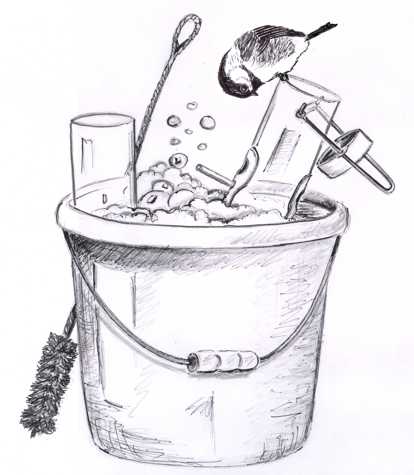
Dear Bird Folks:
This wet spring has my bird feeders looking a little grungy. Any thoughts on how and when to clean bird feeders?
– Paul, Provincetown
Now Paul,
You should clean your feeders now. I said “NOW”, even before you finish reading this. Stand up, open the door, walk outside and take your feeders in. Go ahead, I’ll wait………… still waiting…… did you do it? Okay good. Now take them completely apart. All well designed feeders should easily come apart for cleaning. If your feeders don’t come apart for cleaning, you should fill them with dirt and plant tomatoes in them.
Next, pour yourself a bucket of hot water, then ad a bit of bleach. Dish soap is fine too and the bubbles are fun to play with. Place all of your feeder parts in the tub and let them soak for a while; in your case, Paul, maybe a month or so. After soaking, scrub away all of the goo and scuzziness, rinse well and let everything dry out in the sun, if we ever get some sun. Finally, if you still remember how, reassemble your feeders, fill them with fresh seed, and put them back outside for any birds who haven’t already filed a complaint with the board of health.
Now that your feeders are clean, the best way to keep them clean is to totally empty them every time you go to fill them. Never, ever put fresh seed on top of old seed or “top off” your feeder. Ditch the old seed. Don’t be so cheap. When you fill your feeder, dump the old seed on to the ground for the doves and sparrows. Or, if you are cheap, empty the remaining seed into an empty coffee can. Then add your fresh seed and put the old seed on top. If the old seed ’s dry, it is okay to rotate it, you know, like they do with the milk in the grocery store. They put the old nasty milk out front and the good fresh milk in the back. (Of course we always reach around back for the good milk, but the birds haven’t figured that out yet.)
Keeping your feeders clean and your seed fresh is more important than most people realize. Everyday costomers bring me feeders that need repair, but they don’t seem to notice how disgusting their feeders are. I can’t imagine what these people are thinking. The shower drain at an inner city YMCA has less gooey crap in them than what these people are putting food into. We need to remember that little chickadees, weighing less than a half an ounce, are trusting that the food we offer them is clean and safe.
The endless rain that we have had this spring has made keeping feeders clean particularly difficult. During wet weather it’s best not to use large feeders or at least don’t fill them completely. Bird seed isn’t cheap and if your food gets wet it will spoil and you’ll need to throw it in the trash. That’s right, not on the ground, in the trash. Moldy seed is dangerous to birds, you can’t even throw it over the fence into the neighbor’s yard. And if there is moldy seed or shells on the ground, rake that up too.
A common mistake is filling a large feeder and then going away. Many “weekenders” think that it is important to keep their feeders filled while they are away. The fact is, they may be doing the birds more harm than good. Rotten seed is not safe for birds. If you are not around to maintain your feeders, do the birds a favor and take them in while you are gone. Remember, this isn’t about you and your need to see birds. It’s about providing safe, clean food for the birds that entertain all of us. Believe me, the birds will return when you put your feeders out again. They understand that you are rich, have two houses and are sometimes out of town. It doesn’t bother them one bit. Although, they do appreciate the occasional postcard.